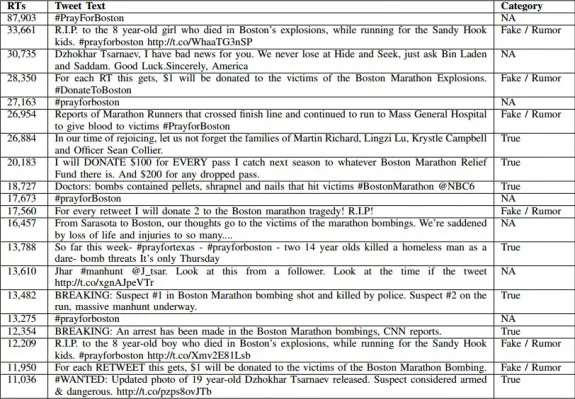In the Wake of the Boston Marathon Bombing, Twitter Was Full of Lies
Of the 8 million tweets sent in the days following the Boston bombing, just 20% were accurate pieces of factual information
/https://tf-cmsv2-smithsonianmag-media.s3.amazonaws.com/filer/2013102402202510_24_2013_boston-marathon.jpg)
From the time two bombs went off near the finish line of the Boston Marathon on April 15, until Dzhokhar Tsarnaev was pulled out of a boat, nearly 8 million relevant tweets were sent by 3.7 million people, say researchers Aditi Gupta, Hemank Lamba and Ponnurangam Kumaraguru. The only problem, according to their new study, is that Twitter was full of lies.
Of these millions of tweets, the researchers say, 29 percent were “rumors and fake content.” Half of the tweets were people’s opinions. And just 20 percent conveyed accurate factual information.
The team found that, of the Twitter accounts spewing nonsense, and especially the ones that initiated the rumors, many seemed expressly intent on causing trouble. From April 15 to April 20, the researchers write, 31,919 new Twitter accounts were opened that had something to say about the Boston bombings. Two months later, 6,073 of these users were suspended.
We found most of these profiles exploited the sympathy of people by using words such as prayforboston, prayers, victims. We can also see the malicious intent of people, as they attempt to create hoax accounts, as indicated by usage of words such as official account. The account BostonMarathons was also one such account which tried to impersonate the real bostonmarathon account.

But though the rumors were kicked off by new accounts or trolls, the falsehoods swept quickly across the network, promoted by prominent tweeters with expansive networks:
We also observed that a high number of verified accounts propagate fake content, which is quite surprising. We can conclude that determining whether some information is true or fake, based on only factors based on high number of followers and verified accounts is not possible in the initial hours. The high number of verified and large follower base users propagating the fake information, can be considered as the reason for the fake tweets becoming so viral.
As Twitter becomes more important as a way of connecting, of sharing news and seeing into breaking events, its susceptibility to the rumor mill becomes more important. Gupta and co.:
Rumors or fake or incorrect information spread via online social media, have resulted in chaos and damage to people in the real world. Specially, during crisis events like earthquakes, bomb blasts and political uprisings, rumors can be very harmful. Malicious entities exploit the vulnerable emotions of people during crisis to make their rumors viral. Online social media, in particular, Twitter, is a mass media with reach to millions of users across the globe. Over recent years, misinformation on Twitter had resulted in damages ranging from financial to human lives. Detection and curbing of fake information on social media, is a relatively new and unexplored domain.
More from Smithsonian.com:
Chechnya, Dagestan, and the North Caucasus: A Very Brief History
/https://tf-cmsv2-smithsonianmag-media.s3.amazonaws.com/accounts/headshot/smartnews-colin-schultz-240.jpg)
/https://tf-cmsv2-smithsonianmag-media.s3.amazonaws.com/accounts/headshot/smartnews-colin-schultz-240.jpg)